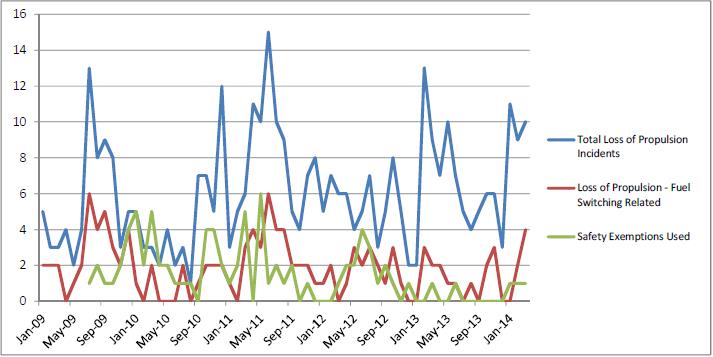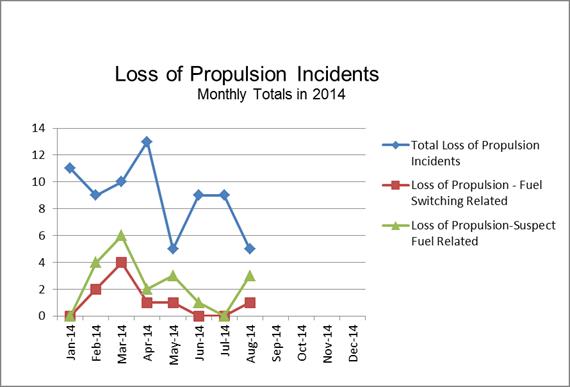California became one of the first places to rigorously regulate the sulphur content of marine fuels used in its ports and up to 24 nm off its shores. Being a pioneer in the field of the mandated use of 0.10 % sulphur content fuel as of January 2014, a lot can be learned from the Californian experience.
The Association is grateful to Messrs. Keesal Young & Logan and Senior Surveys LLC for contributing to this update. Prepared with the assistance of Angad Dhaliwal, Intern at Skuld Singapore.
The development
The upcoming further development of the North American Emission Control Area (ECA), pursuant to the International Convention for the Prevention of Pollution from Ships (MARPOL), will bring about even stricter controls on sulphur emissions by vessels operating along the North American coast. The new regulations, requiring the use of a maximum of 1% sulphur content fuel, became mandatory as of 1 January 2014. Under the new MARPOL Annex VI regulations this limit will be lowered to 0.10% as of 1 January, 2015.
There is, however, one significant place where such strict standards have already been in force for some time, and that is California.
Californian experience
The State of California has been managing the content of sulphur in marine fuels since 2009 and as of 1 January 2014 the permissible sulphur content was lowered to 0.10%. The responsible authority is the California Air Resources Board (CARB) and it must be remembered that in the US there can be local state legislation which is more stringent than equivalent federal legislation. Furthermore each state is free to pass its own laws leading to a situation where significantly different rules may apply between federal to state, and state to state.
One particularly noteworthy development, possibly consequent on this regulatory change, is the increase in the number of vessels suffering from loss of propulsion off the Californian coast.
In many of these incidents it is suspected that the switch over from hot residual heavy fuel oil to comparatively cool gas oil may have led to a so called "thermal shock" to the engines.
It may, however, not just be the temperature change which is causing engine trouble, the significantly lower viscosity of the ultra low sulphur fuel, and its dramatically lower lubricating properties may also be contributing to this situation in terms of increased engine wear and tear as well as breakdowns.
A loss of power is a serious event for a vessel in any circumstance, but should this occur when experiencing heavy weather, restricted navigation and / or other vessel traffic then it can quickly develop in to a serious emergency.
The US Coast Guard District Eleven, which includes the State of California in its remit, published its Marine Information Safety Bulletin 14-01 (reproduced here) to address the issue of fuel switch-over issues.
The data
With the assistance of its correspondent lawyers Keesal Young & Logan as well as expert surveyor J. Arthur Waddington from Senior Surveys LLC, the Association has investigated these issues and can advise as follows.
From available date it would appear that there have been at least 121 loss of propulsion events related to fuel switching in Californian waters since the sulphur content rules were first implemented in January 2009. That would mean an average of about two incidents per month over a period of almost six years.

Data on loss of propulsion incidents 2009-2014
Source: Keesal Young & Logan

Source: Keesal Young & Logan
The analysis
The Association is grateful to J. Arthur Waddington at Senior Surveys LLC for providing the detailed commentary on fuel switch over procedures and issues arising therefrom which is republished alongside this advisory.
It will clearly be necessary to consider these matters at a significant technical level of detail and careful fuel switch over procedures need to be in place for vessels, and engine room teams need to be more than just "generally familiar" with the same, they need to know them closely and be able to consistently put them in to practice. This is after all a serious matter of vessel safety.
A brief summary of the discussion from Senior Surveys LLC is as follows, although for anyone wanting / needing to know more the recommendation is to carefully read the full commentary.
To minimise the potential for problems:
- Know your system
- Test all fuels for compatibility
- Keep track of all fuels on board
- Diligently control all changes from one fuel grade to another
- Ensure the incoming fuel fully displaces the outgoing fuel from the system
Be prepared to react to the following possibilities:
- Blocked filters due to precipitates from mixing fuels
- Sticking fuel pump valves and injector needles
- Gas-locked pumps
- Engine manoeuvring and particularly starting problems
- Increased fuel leakages when running on low sulphur products
- Increased wear rates when running on low sulphur products
Further loss prevention advice
The Association has recently published a detailed guide to the overall picture with respect to the upcoming MARPOL Annex VI Regulations, which members are very much recommended to familiarize themselves with.
Furthermore the Association has provided specific guidance on the North American ECA and the enforcement of the US regulations.
For anyone contemplating US trade, or whose charterparties include the liberty of a North American call, it will be critical to be ready for the significant changes that will come in to force on 1 January 2015.